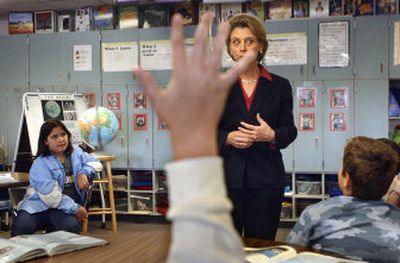Gregoire stresses education

Christine Gregoire couldn’t help but be impressed Monday with how knowledgeable fourth-graders at Arthur B. Ness Elementary School were about China.
The governor peppered the students with academic fastballs about the state’s $8-billion-a-year trade partnerships with Japan and China and the kids just knocked ‘em right back.
“What does China buy from Washington”?
Apples.
“What else?”
Airplanes.
“What else?”
Wheat.
“What else?”
Software.
“What else?”
Starbucks.
“What else? Anyone?”
Jobs.
Jobs, the governor warned, are things China will want in the near future that Evergreen-staters will surely balk at giving, but may have to relinquish if Washington’s children aren’t college educated. Pacific trade has been on Gregoire’s mind since she returned from an 11-day trade mission to Japan and China two weeks ago.
Fifty years ago, when Gregoire was a child, American parents would raise, at the dinner table, the subject of starving Chinese children in order to guilt-trip U.S. children into eating. Now there’s a new hunger, perhaps more serious.
“What I say to my two girls is ‘if you don’t do your homework and you don’t graduate from high school and you don’t go to college, your job will go to China,’ ” Gregoire said. “And that’s true.”
The governor, a Democrat, met with the fourth-graders at Ness because students at the Spokane Valley school are at the head of the class statewide when it comes to the Washington Assessment of Student Learning test, or WASL. Ness fourth-graders weren’t expected to perform so well on the multipart test given statewide to students in fourth, seventh and 10th grades because a large percentage of its students come from low-income families. Statewide, schools with more low-income students don’t fare as well on the WASL as schools overall and don’t show much improvement on subsequent tests.
Nearly two-thirds of Ness’ students receive the kind of free or reduced-cost school lunches for which low-income families qualify. Yet, since 2000, more than 68 percent of the school’s fourth-graders have passed the math sections of the WASL. For five years, 75 percent of the students have passed the reading test.
With the governor Monday were members of the Washington Learns Steering Committee, a blue-ribbon panel working to identify inefficiencies in the state’s current education system. The committee hoped to glean answers from Ness on how to improve WASL scores at other schools. Ness officials credited much of their success to closely monitoring student performance and zeroing in quickly on students in need of extra help.
Though it will be eight more years before the governor knows if Ness students will heed her advice about higher learning and the world job market, statistics now show that most Washington high school students do enroll in college after graduation.
In 2003, roughly 63 percent of the state’s high school graduates went on to college the following fall, said Dave Pavelchek of the Social and Economic Sciences Research Center, a research branch of Washington State University. The most recent data available, the 2003 statistics, indicate that of the 63 percent of graduates who attended college, slightly more than half attended two-year schools. The rest attended four-year schools.